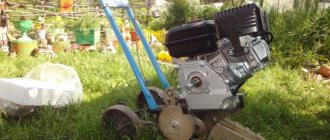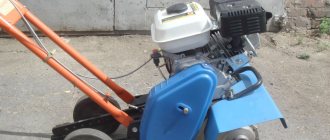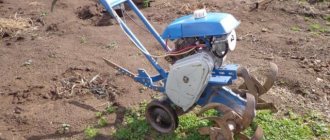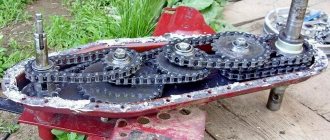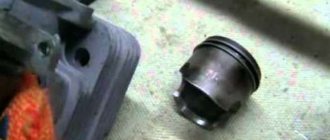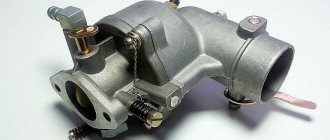On the eve of the next summer season, we are all faced with the need to till the soil. Most people use mini-agricultural equipment for this, namely a cultivator or walk-behind tractor. Moreover, the Soviet cultivator “Mole” is known to everyone.
As a rule, this unit was purchased en masse 10-15 years ago and served faithfully for quite a long time. As a standard, this cultivator was equipped with a 2.6 hp two-stroke engine; modifications were produced with rear speed and only with forward speed.
At the moment, for most gardeners, the “Mole” cultivator has served its useful life and requires thorough repairs. As a rule, the quality of modern spare parts leaves much to be desired, and the original parts are worn out. After replacing one part, another breaks.
If the gearbox is working properly, then it is enough to replace the motor on the cultivator. Nowadays, stores offer a large selection of engines from different manufacturers. To work in your dacha, feel free to choose engines from well-known Chinese manufacturers, such as Champion, Forza, Lifan, etc. The main thing is to contact trusted sellers. Before purchasing, be sure to request a pre-sale inspection, that is, it must be filled with oil, gasoline and started. Fuel and lubricants are paid by the buyer.
For the Mole cultivator, a 4 hp engine is sufficient; you can also install 5.5 hp, 6.5 hp engines.
Important! A flooded engine must not be turned over.
Next is the question of installing a new engine on the Krot cultivator. Let's figure out what this requires.
1.Pulley
The pulley must be selected depending on the diameter of the shaft on the new engine. As a rule, it comes in 18 mm, 19 mm, 20 mm.
2.Oil
The new engine is four-stroke, so you need to buy special oil for 4-stroke garden equipment. Automobile is not allowed. Do not forget that oil is poured separately, gasoline - separately (AI-92). The first oil change is performed after 5 operating hours. Therefore, they usually purchase two bottles of oil (one of which is filled during pre-sale inspection).
3. Bolts, washers, nuts.
You will need bolts to secure the engine to the frame and the pulley to the engine.
4. Throttle cable.
The cable is installed as desired.
Now let's move on to installing the engine on the Krot cultivator.
Depending on the modification of the cultivator, the new engine either fits perfectly into the frame, or two additional holes will need to be drilled.
Step 1
On the engine, you need to install the pulley on the shaft, insert the key, adjust the distance from the engine to the pulley with washers, and secure the pulley with a bolt and washer.
Step 2
Let's try the engine on the frame. At the same time, we put the belt on the engine pulley, gear pulley, and tension roller.
In our case, the holes did not match, so we had to drill new ones.
Step 3
We install the engine on the frame, fasten everything with bolts.
Step 4
We make sure to make wings for the cultivator, otherwise all the dust during cultivation will get into the engine and the air filter will get dirty very quickly.
Step 5
Let's get to work. Under no circumstances should we work at idle speed! At most, we warm up the engine for a couple of minutes and get to work. The only thing is that at first we work in a gentle mode: after 10-15 minutes we let it cool. The first oil change is after 5 operating hours.
Motor cultivator device
The Mole motor-cultivator, as well as the Cayman, Patriot, Texas, Foreman, Crosser, Viking, Forza motor-blocks, is quite popular in the post-Soviet space, which is explained by the simplicity of its design and fairly good performance indicators.
There is absolutely nothing superfluous in the configuration of this walk-behind tractor, but its structure is designed in such a way that it is able to cope with basic agricultural work - digging up beds, cultivating the soil, etc.
In addition, the design of the main working units allows it to withstand quite long loads, ensuring stable operation for many years.
For more information about the Mole walk-behind tractor, watch the video:
the Mole walk-behind tractor itself consists of the following components:
- The frame structure, consisting of two half-frames, is attached to the gearbox with bolts.
- Tubular-type handles, as well as a special bracket for attaching additional attachments located at the rear of the structure.
- The main control elements are located on the handles - adjusting engine speed and clutch.
- The output shafts of the gearbox can be equipped with rototillers, as well as wheels, allowing the walk-behind tractor to be used together with a plow, or for transporting various loads.
- The frame structure houses the motor for the Mole walk-behind tractor, which is connected to the input shaft of the gearbox through a V-belt transmission.
- In addition, the design has built-in wheels that allow the unit to be moved freely. When starting to work with a walk-behind tractor, these wheels must be removed from the structure, or raised and fixed in the desired position.
As we can see, the device is quite simple and does not include unnecessary frills. In principle, everything you need for high-quality work on the ground is in the design of this unit and in the Sadko, Don, Khuter, Profi, Plowman, and Champion walk-behind tractors.
As for the factory engine of the Mole walk-behind tractor, its design is a 2-stroke engine with one cylinder and air cooling.
Its volume is about 60 cm3, with a power of 2.6 hp. and 6000 rpm. It is started using a regular cable, similar to the principle of starting a chainsaw.
It needs to be refilled with a special mixture consisting of gasoline and motor oil. These characteristics are quite modest, so many people want to change it to more powerful models.
Replacing the factory engine can be done independently , because the Mole design, as mentioned above, does not pose a certain complexity in its understanding. Most often they resort to replacing engines with 4-stroke versions, because they have higher performance characteristics than 2-stroke ones.
Of course, there are some modifications, such as the Mole walk-behind tractor with a 4-stroke Honda engine, but its cost will be significantly higher than that of the standard Mole. That’s why we are considering the “worst” option, when we have a walk-behind tractor with the most standard factory engine, with a power of no more than 3 hp.
Common breakdowns
What machine elements may require the operator's close attention?
Engine Magneto MB-1K Carburetor K60V Gearbox Air filter
Let's list them:
- motor;
- magneto, ignition system;
- carburetor;
- gearbox;
- air filter, etc.
Now let’s take a closer look at all those malfunctions that can affect the performance of the unit, no matter what model it belongs to.
Spark plug
Does not start
So, what to do if the “Mole” does not start, what could be the reasons for this? The ignition fails or there is no ignition at all in the following cases:
- No spark. This could mean the spark plug is burnt out. In this case, you need to unscrew it and simply replace it with a new working one.
- The spark plug is smoked. A good cleaning will bring it back to life (remove carbon deposits, clean the contact), after which the spark plug must be thoroughly rinsed in gasoline.
- If the cultivator does not start, but there is a spark, then most likely the reason is a lack of insulation. We look at the candle again, in this case it is wet or slightly damp. You don't have to change the entire spark plug; you only need to replace the tip.
- Poor quality fuel may cause the cultivator to fail to ignite. It is for this reason that the spark gets wet, after which you will have to change the tip.
- Fuel dripping from the spark plug is another reason why the car will not start. To rectify the situation, it is necessary to drain the cylinder by bleeding the engine using a manual starter.
- The reason for the lack of ignition may also be problems with the fuel supply hoses. To restore the operation of the cultivator, it is necessary either to properly tighten the hoses, or, in case of rupture, replace them with new ones.
- Poor insulation of the electrical system (high and low voltage wires) can also cause the unit to not start.
- Pay attention to the air filter. If it is dirty, then problems with ignition are guaranteed. It needs to be either cleaned or replaced. Most often they resort to the second option, fortunately, this spare part is available both in price and in availability in the store.
- Failure of the magneto itself. This part cannot be repaired and is immediately replaced with a new one. How to check the magneto of the “Mole” motor-cultivator to make sure it is faulty? Yes, it’s very simple - if all the reasons why there may be no spark are excluded, then the cause of the malfunction is in the magneto. Many craftsmen rework the working magneto, thereby increasing its service life.
This is what the Magneto ignition circuit for the “Mole” motor cultivator might look like
Magneto circuit
- There may be no ignition if the flywheel plates jam the magneto cores.
- An incorrectly set gap between the electrodes will not allow a spark to escape.
Video review of the modernization of the ignition of the “Mole” motor cultivator
As you have seen, setting the ignition is not so difficult.
Engine
The main reasons that the “Mole” engine does not start are:
- lack of fuel (or its low quality);
- ignition problems discussed above;
- the appearance of decompression and, as a result, piston wear and deformation of the exhaust valve.
Oil M8-B
In the first case, it is enough to simply fill in the required amount of fuel (a mixture of gasoline with M-8V autolom oil) and all problems will be resolved. In the case of a compression failure, you will have to completely disassemble the engine and replace damaged parts, and this could be a piston or an o-ring.
Deformation of the exhaust valve becomes another cause of compression failure, which leads first to a loss of power of the “Mole” motor-cultivator, and then to starting problems.
To restore engine functionality, it is necessary to completely disassemble it. Having assessed the condition of the piston, replace it if necessary. We change the piston rings and exhaust valve. We examine the engine head, in particular the gas distribution mechanism, and if there is carbon deposits, we clean it. If structural elements are damaged, we replace them with serviceable ones.
Motor selection
During the Soviet Union, only domestically produced two-stroke single-piston engines were used, which were not particularly powerful. Today you can find “Mole” with a four-stroke imported engine. But if you still have the first model of a cultivator in your arsenal, then upgrading your “Mole” by replacing the motor is not at all difficult.
And here a new question arises: which engine is better to install on the unit? It’s not difficult to answer - those models that are installed in newer cars are suitable.
Hammermann CF 168 F65 engine GeoTec engine Subaru engine Honda GX160 engine Briggs&Stratton 550 engine Lifan 168 F-2 engine
It is best to replace the domestic engine with an imported one:
- Hammermann
- GeoTec
- Subaru
- Honda
- Briggs&Stratton
- Lifan
Any of them will not only give the motor-cultivator a new life, but will also significantly increase the power and service life of the unit.
Engine Lifan 168 F-2
An excellent solution would be to install the Lifan engine on the “Mole” motor-cultivator. Such a motor provides the car with a long life, because in addition to reliability and efficiency, Lifans also stand out for their unpretentiousness and definitely do not require additional attention.
Video review of replacing the engine on a Lifan 168 F-2 with a Mole cultivator
Carburetor
Carburetor K60V
What is a carburetor and why do you need to adjust it? A carburetor is a small device designed to produce a fuel-air mixture. This mixture, with the help of a piston and a spark plug, will be maximally compressed and ignited, and the engine will start and continue to operate.
Carburetor adjustment must be carried out after the first working season.
Carburetor adjustment is one of the mandatory points included in the “maintenance” section of the unit. Thanks to timely inspection and repair, the service life of the cultivator will increase. In addition, inspection and adjustment are also necessary when the engine roars strongly for no apparent reason.
Before we start setting up, we need to familiarize ourselves with the design of the carburetor of the “Mole” cultivator:
K60 carburetor design
So, to debug the fuel supply and ensure the required speed, you need to turn to two screws: the number of revolutions (in Fig.) and the quality of the fuel (Fig. ). Using these two screws, we adjust the fuel supply to the carburetor of the “Mole” motor-cultivator at idle speed. You must act very carefully; first check the state of the ignition.
Important! Thoroughly clean the carburetor, where necessary - strip it, wash it, where necessary - change parts. Then the Mole motor cultivator will serve you for a very long time.
Owners of the unit are often interested in how to start the “Mole” cultivator after winter. The reason for the lack of ignition is condensation in the carburetor that has accumulated during inactivity at changing temperatures. Complete disassembly of the device and further cleaning will help solve this problem. All kinds of additives found in low-quality fuel and dust that has seeped through the filter will also not contribute to the operation of the device.
Gearbox
Gearbox
The main task of the gearbox is to transmit torque from the engine to the shaft. The transmission of motion is carried out using a V-belt transmission. You can learn more about the design and repair of the gearbox of the “Mole” motor-cultivator by watching the video.
Video review of the Mole motor-cultivator gearbox
Reverse
Reverse circuit
The first modifications of the “Mole” are not equipped with a reverse function (reverse speed), which somewhat affected their performance characteristics and ease of working with such attachments as a cart, snow blower, mower, etc. To modify the “Mole”, the manufacturer released new modifications of it , already with a reverse function, which significantly increased the mobility of the cultivator.
Video review of the reverse function on the Mole motor-cultivator
Drive belt
Drive belt
The drive belt transmits torque from the engine to the gearbox. The cause of breakdown of the “Mole” motor-cultivator is often a rupture of the drive belt. This occurs due to the belt jamming during operation due to heavy loads on the working parts of the cultivator (hard soils, blunt cutters). The cutter bends and catches the belt with the knife, thereby rendering it unusable.
Drive belts for the “Mole” cultivator can have various modifications, but their dimensions are strictly defined:
- 710 mm;
- 750 mm.
What type of electric motor can be installed on the Mole cultivator?
The design of the Mole walk-behind tractor frame allows it to be equipped with other engines produced at various factories. At the same time, the alteration of the frame will be minimal, consisting of a few simple manipulations.
Lifan
Many note that the optimal choice for installation on the Mole would be the Lifan 168FB engine, whose power is 6.5 hp. This is explained by the fact that spare parts for it are quite cheap and accessible, so they can easily be found in any specialized store.
As practice shows, you need to use a 20 mm pulley shaft (there is another type of motor with a 19 mm diameter). It is also important that the air filter has an oil bath, because such a device is used specifically for areas where there is increased dustiness.
Motor Patriot
In addition, you can install a Patriot electric motor for the Mole walk-behind tractor, the cost of which is within 6 thousand rubles. The only thing is that you need to take care of electricity in your area so that the device can work stably.
Sadko
A good option comes from installing a SadkoDE-220 engine on this walk-behind tractor, the power of which is about 4.2 hp. The diameter of the shaft is 19 mm, it is launched using a cord.
One of the most labor-intensive activities in agriculture is grain harvesting. The Polesie combine harvester is of excellent quality for decades.
Snow is not the best surface for cars, so in snowy areas it is necessary to use other means of transport, such as a snowmobile. Here is all the information about the beautiful Varyag 550 snowmobile.
An electric sprayer is an important and highly effective tool in the competent organization of work in a garden plot, allowing you to protect the plant, fertilize it in a timely manner and carry out preventive maintenance. By following the link you will learn how to make a sprayer with your own hands.
In principle, these are the most optimal engine options that can be installed on a Mole. In principle, you can try to install other models, but it is important to remember that their power should not be too high.
In principle, 6 horsepower is quite enough for this design of a walk-behind tractor, because the use of high power can lead to excessive load on the gearbox, which is why it can quickly fail.
Do-it-yourself motor cultivator repair
The motor cultivator has the following components:
- Fuel system (carburetor, fuel tank, air filter and fuel supply hose).
- A starter (manual or electric), it is used to spin up the main shaft using a special cable.
- The cooling system operates under the influence of the rotation of the crankshaft and supplies cold air at flywheel speeds.
- The ignition system makes and supplies a spark in the design of the cultivator.
The sooner you understand where the breakdown is in your device, the faster you will fix it and repair it.
Most breakdowns occur due to motor failure. If this is indeed the case, then you need to check:
- Is this part heated, especially in winter?
- Is the air filter clean?
- Serviceability of the ignition system.
- Are all piston elements intact? You also need to check whether this part is installed correctly (fastening and location itself).
Cleaning the carburetor of the unit yourself
Most often you just need to disassemble and clean it. Detailed information about this can be found in the manual for using the motor cultivator, which also contains a drawing of the equipment. All this is so that the carburetor float sinks back evenly. It is also necessary to eliminate the deformation of the bracket with which the float is installed to the piston system. A screwdriver will help with this; everything needs to be done clearly and carefully.
You should also adjust the valves of the cultivator correctly. To do this, you need to examine the tightness of contact with each other; after this procedure, the functionality of the carburetor increases and the amount of gasoline consumed returns to normal.
Fuel supply pump repair
The engine is the most important part in any mechanism, but often it does not start for some reason, for example, when there is a problem with the fuel pump. It works as long as fuel enters the pump; when this does not happen, the pump breaks down. In this case, it is urgent to inspect, disassemble, clean and correct all violations. It is possible that the pump is dirty, then it should be cleaned and reinstalled.
Important! If you have a two-stroke engine and use a gasoline-oil mixture, then you must flush the entire fuel system with clean gasoline.
Also, the engine may stall, then the cause of the breakdown may be poor operation of the unit. There may also be a problem with the ignition; here you should check the spark plugs and if they are faulty, then you need to install new ones.
If the engine is running with a knock, the reason may be damage to one of the internal parts (cylinder, bearing, piston, perhaps a ring has fallen off the piston). Here the repair consists of replacing faulty parts with new ones.
The cultivator motor may also make a hum. The problem may be an overheated engine or the use of low-quality fuel. In this case, it is recommended to work at a slightly lower speed or replace it with high-quality gasoline.
If the cultivator's arms (mills) do not work, then most of all this indicates that something is stuck between them and is preventing the engine from continuing to operate normally. If not, then it’s worth checking the following parts: fastening, pulley, position of the idler gear and drive belt. If this is the case, then you just need to change this element or install a new one, this can be done with everything except the pulley. You cannot repair it yourself; you should take it to a service center.
Attention! Very often, problems arise not in the breakdown of one or another element, but in ordinary contamination, so always immediately before working with a motor cultivator you need to check all parts for cleanliness and serviceability. After all, most often a simple blockage entails many serious problems and breakdowns.
If there are problems with the gearbox, reverse gear is not normal, then you need to check the serviceability and integrity of this part, because often the cause of the breakdown is the old age of this element. Then you need to replace not only the gearbox itself, but also the reverse.
If there are problems with the ignition system, you must first check the fuel by removing the spark plug. If it is wet, it means it is coming. You also need to check for a spark between the electrodes; if there is none, then look for a breakdown in the generator circuit.
If the engine power loses its strength, then it is necessary to check the carburetor, gas hose and air filter, because problems with these parts often occur due to their clogging or contamination.
If your cultivator does not have compression, then you need to check and replace the cylinder, piston and piston rings.
Rules for working with a motor cultivator:
- It is necessary to warm up the engine for at least five minutes and only when all the components are warmed up can you start working.
- For refueling, use only high-quality and fresh fuel mixture.
- Warm up or operate the cultivator more often than once every three months.
- Change the oil seals in a timely manner and lubricate the gearbox (only with high-quality lubricant).
- Check and clean the air filter once every three months.
- The engine should not be left idle for more than 10 minutes. This may cause the crankshaft bearing to seize.
If you follow these basic rules, you will see how much less your cultivator breaks down and how much longer it will serve you.
Instructions for replacing and installing the engine on a walk-behind tractor
As already mentioned, you can install a variety of engines on the Mole walk-behind tractor. It is only important that this installation takes place in the correct sequence, in strict accordance with the basic recommendations. By the way, stores sell special installation kits for correctly attaching the motor to the frame.
This is a perfectly acceptable option for those who have extra funds, but we will consider the option of directly installing the new engine on the Mole frame structure.
Let's look at the example of a 4-stroke Forza 160F engine , which has 4 hp. This choice is not accidental, because it runs on standard AI-92 gasoline, which is more preferable than the mixture used on the factory Mole engine.
This engine for the Mole walk-behind tractor also has increased technical data, which naturally affects its cost - the average price for such a unit is about 7 thousand rubles.
Capabilities and applications
The main purpose of the Krot motor cultivator is to cultivate the soil, and therefore it is usually used in vegetable gardens or personal plots. The equipment, small in power and size, is used for leveling, loosening, and harrowing land in areas whose area does not exceed 10 acres.
This device can perform basic operations using a cutter, the torque to which is transmitted from the motor. When using other attachments, you can use a walk-behind tractor for hilling and mowing grass. In some cases, it is used as a drive for a pump to pump liquid, connecting the engine via a belt drive to the pumps. The “Mole” can transport a load of up to 200 kg if equipped with a tow hitch and a trolley.
This device is relatively easy to use and maintain, and does not take up much space when stored.
Possible malfunctions, their elimination, repair
Each type of technology has certain characteristics. This also applies to Krot motor cultivators, so strict adherence to the manufacturer’s recommendations is the key to long-term uninterrupted operation of the machines.
As the experience of most equipment owners testifies, the main causes of malfunctions and breakdowns of the Mole MK-1A-02 motor cultivator come down to one thing: contamination of parts, components and mechanisms. Therefore, keeping agricultural machinery clean and timely maintenance should be the main rule of successful operation.
- If the carburetor is dirty, the Mole MK-1A-02 motor-cultivator will overheat and stall.
- The engine may not develop sufficient power due to clogging of the carburetor, the appearance of carbon deposits in the muffler, on the cylinder channels, or clogging of the engine air filter. The reasons may also be an increase in the tension of the V-belt, lack of compression.
- Do not use pure gasoline, not mixed with oil, as fuel.
- Do not use motor oil of brands that are not specified in the operating instructions.
- Do not idle the engine for more than 10 minutes - due to low fuel consumption, the crankshaft bearing is not cooled enough and quickly overheats, which can lead to seizure.
- For easy engine starting, promptly clean the drainage hole in the fuel tank cap and the filter element.
- Due to insufficient engine warm-up, a dirty spark plug, or improper installation of the high-voltage wire tip, the engine may stall or operate intermittently.
Magneto - ignition system control
The system is tested visually, using a probe to measure the gap between the electrodes. For a detailed inspection of the magneto, remove the casing and flywheel and make the necessary adjustments in accordance with the instructions.
When adjusting the gap, in order to avoid damage, do not press forcefully on the central electrode.
Mole cultivator ignition system
The operating instructions for the Krot motor-cultivator provide very detailed information about the design of the unit, the schedule of routine maintenance, setting up systems and mechanisms, causes of problems and their elimination:
The best motors
Various types of motors are installed on the Mole walk-behind tractor, which increase the performance of the device and also allow it to be used more efficiently. Such units can be installed independently if the rules are followed, and before purchasing it is important to determine their power in order to choose the optimal engine for agricultural activities.
Honda GX270
The Japanese-made Honda GX270 engine can be easily installed on a walk-behind tractor to ensure ideal operation of the unit in extreme conditions. The volume of such a four-stroke power unit is 270 cubic centimeters and the power is 9 liters. With. This internal combustion engine has an air cooling system and is easy to repair if malfunctions occur. To increase the engine's service life, it is recommended to fill with AI-95 fuel.
As engine oil, you can use 10W40 or 10W30 fluids, which are recommended by the machine manufacturer. The power unit of the device has a sensor, thanks to which you can monitor the amount of oil in the crankcase and add it in time. Honda engines are the most optimal devices for installation on Mole walk-behind tractors.
Which engine to choose for the Mole walk-behind tractor?
Hello! There is a “mole” walk-behind tractor manufactured in 1991. The original engine was removed. I want to install a diesel engine. No more than 6 hp Which engine is better to buy, made in China or Slovenia?
Zames It’s easy for you to choose here since Slovenia does not produce walk-behind tractors or engines for them.
Riba4ok1 Produces engines. Brand "Sadko"
Zames wrote: I have a mole walk-behind tractor manufactured in 1991. The original engine was removed. I want to install a diesel engine. No more than 6 hp
Why buy a light motor cultivator, a diesel engine that can also power a mini tractor?
Any gasoline 4.5 hp. he has enough to spare.
umnyi I want to attach a homemade plow and a trailer to it) And I don’t like gasoline engines
The Ukrainian heavy MS walk-behind tractor has 4.5 hp for almost everything, and it weighs 217 kg as standard. Recalculate hp. per 1 kg Your right! The mass of the mole is simply not enough to power 4 diesel horses; perhaps the gearbox will simply grunt quickly. You will use 1/4 of the engine's power, running almost at idle (which, by the way, is not good) and that's it. Then take it with an electric starter
at least it won’t hurt later. There will be a mega-pumped Mole.
umnyi Then buy a 4.2 liter “sadko” diesel engine.
But still. Which is the best engine brand?
Zames If the difference in cost is ten bucks, what difference does it make what brand it is? They are all riveted at almost the same factories and they put on different stickers. If you were choosing between HondaSubaru and a bunch of Chinese clones, you could talk about something. Better look at the cost of consumables for the engine and their availability, otherwise if the air filter costs as much as a third of the engine.
Zames, you need to take the 168FB engine, 6.5 hp. Because it is the most common, spare parts are cheap and are always available (just in case), and the filters for it cost pennies. Take one with a 20mm shaft (and the bolt at the end of the crankshaft will be a regular M8, and not an exotic one with an inch thread), and also make sure that the air filter has an oil bath (for conditions of increased dustiness). By brand - WEIMA is the best (but also more expensive) - it is a real manufacturing plant, and not a sticker brand. They have better quality parts, the crankshaft and flywheel are balanced, and there is minimal vibration. They have a new line of engines - with a larger gas tank, a round “cyclone” air filter.
Motoblock device
The Mole walk-behind tractor is a frame structure divided into two half-frames. At the top there are tube-type handles and a bracket for mounting attachments located on the rear side. The controls are located on the handles: clutch and speed switch. Some models also have a reverse switch.
The device is equipped with four cutters, 2 external and internal, as well as a coulter. Additionally, a hiller for beds, a potato digger or plow, a pump for water supply, and a mower are installed.
A two-stage gear-type gearbox with a chain drive and an internal combustion engine, which are connected to each other by a V-belt transmission, are bolted to the supporting frame. Above them is the fuel tank.
The clutch of the minitractor is disengaged and is switched by a handle like on a moped. Engaging the clutch provides belt tension to transmit torque without slipping.
Mills for cultivating soil or wheels for moving loads or sharing with a plow are mounted on the output shafts of the gearbox. The cutters serve as the main working body and consist of a rotor with special knives. They rotate and cut, crush and mix the soil as they gradually move forward. The working depth will depend on the length of the opener used.
The milling cutter loosens the soil and mixes fertilizers more thoroughly than a plow. Shows good performance on heavy soils and virgin soil.
The Mole walk-behind tractor moves freely on built-in wheels. Before starting work, they are removed or raised, fixing them in the desired position. During the first 15 hours of operation, do not give full load. At this time, the parts are being run-in. With a “shock” rate of use immediately after purchase, the performance of the motor decreases.
Operating instructions: service features
The Mole MK-1A-02 motor cultivator is easy to maintain and operate. It consumes as fuel a mixture of gasoline AI-76, AI-80 with motor oil M-12-TPTU in a ratio of 25:1. MG-8A oil is used for the engine gearbox, and TAD-17 oil for the output gearbox.
Design of the MK-1A-02 cultivator
MK consists of the following main components: engine 18; gearbox 28; frames 2, 22; working bodies - rotors 24, 25, 26, 27 with knives; wheels 23 (transport); fuel tank 5 with lid 6 and hood 7; petrol tap 4; pipes 8, 17; control handles 12, 14; control levers for clutch 11, throttle 13, reverse and forward gears 15; clamp 9; casing 3; supports 19, 20; opener 21; “Stop” buttons 10 stop the engine; electrical connector 16; shield 29; protective shields 30; handles 1.
For a new cultivator, the first 15 hours of operation are a break-in period - the running-in of the main components and mechanisms. During this period, it is prohibited to use the equipment at full capacity.
Various mounted implements can be installed on the motor cultivator: hillers, weeders, trolley, mower, motor pump, plow, snow blower. Thanks to the reverse gear, the unit has good maneuverability, especially in confined spaces in greenhouses and vineyards.
Specifications
- The working width is 400-600 mm;
- Rotor diameter with knives – 320 mm;
- Tillage productivity – 150-200 m 2 /hour;
- Cutting depth – 250 mm;
- Overall dimensions in working position: length – 1000-1300 mm, width – 350-800 mm, height – 710-1060 mm;
- The weight of the walk-behind tractor with an empty tank is 51.5 kg.
Engine Description
In the classic version, the Mole engine is a single-cylinder, two-stroke with a carburetor and forced air cooling.
The motor is equipped with a non-removable starter. It is started manually using a cable, similar to a chainsaw.
- Working volume – 60 cubic meters. cm;
- Power – 2.6 hp/1.91 kW;
- Rotation speed – 5500-6000 rpm;
- Average fuel consumption – 0.96 l/kW h;
- Fuel tank capacity – 1.8 l;
The carburetor design is the same as on mopeds of the Soviet period Riga, Verkhovyna or Karpaty.
The motor uses a dry air cleaner with a replaceable filter element.
It should be fueled with low-octane gasoline A-76 with the addition of M-8B1 motor oil (Avtol), maintaining a ratio of 1:20.
The ignition is contactless, electronic model “MB-1”, like on Soviet chainsaws with an “A-17B” spark plug. Installing spark plug “A-11” ensures stable engine operation without carbon formation.
Modifications of the Mole walk-behind tractor are equipped with more powerful 4-stroke engines made in China.
Which engine is suitable for the Mole walk-behind tractor?
The “weak link” of the Mole walk-behind tractor is the engine, which lacks performance and is difficult to start. The owners of the unit are trying to solve this problem on their own.
The design of the Mole frame allows you to replace the engine with a device from another manufacturer. The modifications required are minimal and uncomplicated, so they can be done independently. In most cases, the standard engine of a walk-behind tractor is replaced with 4-stroke models with better performance characteristics.
The optimal replacement solution is Lifan 168FB with a capacity of 6.5 liters. With. It is easy to find spare parts for this motor in a specialized store at an affordable price. When choosing, you need to check the diameter of the input shaft. It should be 20 mm. For reliable operation of the device, an oil bath with an air filter is preferable, because the engine will have to be operated in dusty conditions.
A good solution would be the Patriot engine. It won't cost much. The only condition is the presence of electrical wiring on the site.
The Honda GC 135 engine is suitable for any operating conditions and consumes little fuel. The professional design of the 4-stroke motor features a single-block aluminum cylinder with a timing belt. It is lightweight and environmentally friendly.
Suitable for installation on Mole walk-behind tractor Sadko DE-220 engine. Its power is about 4.2 liters. s and the output shaft has a diameter of 19 mm, so the pulley will have to be modified. The device is started via a cord.
The Forza 160F 4-stroke engine with 4 hp has improved technical data. With. To operate, it will require AI-92 gasoline.
The motor for the Mole walk-behind tractor can be installed in other models, but only of low power. It is enough to limit yourself to 6 liters. With. A powerful motor unnecessarily loads the gearbox and leads to breakdowns.
Review of the model range of Mole motor cultivators
Mole MK-1
- Has low power (2.6 hp).
- Primitive device: engine (imperfect), gearbox, frame, handle, bracket.
In this video we will review the Mole motor cultivator:
Motor cultivator model Mole MK-1A
- Convenient, small in size and weight (only 48 kg).
- The ability to complement and expand the operational variations of this product.
- Reverse speed available.
Mole MK 3-A-3
- One axis.
- Quite light (approximately 45 kg).
Mole 3 DDE V 800 II
- Power – 7 hp
- The engine can withstand long periods of loads with low fuel consumption.
Mole MK 5-01
- Quite powerful Japanese Honda engine (4 hp).
- Also two gears.
Mole Subaru Robin
- Powerful Japanese engine (3.5 or 4.5 hp).
- Has two speeds.
Mole M
- The model with the smallest dimensions.
- There is a transport wheel.
- Honda engine.
- Lightweight (weight only 48 kg).
The Mole brand of walk-behind tractors offers many different models (from those that are cheaper to more expensive, respectively, with good, powerful parts for heavy, long-term work and a little simpler).
Mole Om
- The engine is two-stroke, carburetor.
- Has low power (2 hp).
- Engine capacity – 60 cm³.
- Quite a light device.
Technical characteristics of motor cultivators Mole MK-1A-01TS
- Small-sized agricultural machinery for shallow (25 cm) cultivation of the land, loosening it, leveling it, weeding rows, and so on.
- It has a small weight (approximately 45 kg).
- With the help of additional attachments, it can hill up, weed between rows, transport various materials, mow grass, etc.
- New improved parts provide reduced fuel consumption and reduced noise levels.
- Reverse gear available.
Mole MK-2
- Four-stroke engine (power – already 3.6 hp).
- Availability of two speeds.
- Improved chain reducer.
- Can handle difficult, hard ground.
Mole MK-9-01
- Four-stroke petrol engine, power (5.5 hp).
- Can treat areas up to 25 cm deep.
- Copes with the following jobs: digging, cultivating, loosening beds, leveling the ground, weeding rows.
- It has a highly reliable imported gearbox and a unique design of cutters (this motor cultivator can cultivate even the heaviest areas of land).
Mole 05-01
- It has a long-lasting gasoline engine of the Honda model (4 hp) with good balance.
- It can perform many functions (ploughing, weeding small gardens, processing clay soils).
- It has considerable weight (57 kg).
- A good chain reducer with low losses and long service life.
- Can move in reverse.
- Promptly cultivates large areas of land.
- Easy to use and learn.
How to make a replacement
Trouble-free operation of the mini tractor will depend on compliance with the installation and connection sequence.
- Unscrew the factory fastening and remove the casing.
- Disconnect the wires and disconnect the belt.
- Carry out dismantling.
- Attach the new engine and mark the new mounting holes on the frame.
- Install the engine and put on the belt.
- Adjust the belt tension by moving the motor.
- Align the unit so that the motor pulley and gearbox are in the same plane and positioned coaxially.
- Drill through holes and secure the walk-behind tractor engine with bolts 35 mm long.
- Connect the clutch, gas and muffler system.
- Carry out a run-in at idle speed.
About the disadvantages of a walk-behind tractor
The multifunctional walk-behind tractor Mole has its drawbacks:
- The main disadvantage of the device is its low-power engine. With more volume there would be more opportunities.
- The open type design leads to severe contamination during operation. Dust clogs hard-to-reach places where there shouldn’t be dirt.
- Stones, roots, clods of earth get into the gap between the body and the knives, making work difficult.
- Only one operating speed.
- The service life of a 2-stroke engine does not exceed 400 hours.
- A narrow strip of land is processed in one pass.
- The piston group fails after 1-2 years and must be replaced.
- After replacing the engine with a more powerful model, the frame has to be strengthened with additional parts.
- High price of the unit.
Basic faults
The MK-1A-02 “Mole” motor cultivator sometimes requires repair. Let's consider the main breakdowns that require immediate operator intervention and quick repair of the unit:
- No ignition.
- Air filter dirty.
- Gearbox failure.
- The engine gets hot and stalls.
- Extraneous noise in the walk-behind tractor.
There may be several reasons for unit failure:
- Failure or contamination of the spark plug. In this case, the spark plug must either be thoroughly cleaned and rinsed, or completely replaced.
- Problems with the gasoline supply hose.
- The insulation of high-voltage wires is damaged.
- Problems in connecting wires (the electrical network does not connect).
- The filter is clogged. It can be cleaned, and if it is heavily soiled, it can be replaced; fortunately, this spare part is always available for sale.
- The flywheel plates jam the magneto cores.
- The carburetor is dirty and therefore the car stalls (heats up). It must be washed thoroughly; if the problem persists, replace it.
- If there is any extraneous noise, add oil.
- If the engine stalls, check to see if the fuel has run out.
- Pay attention to the gearbox; it may be necessary to tighten the bolts and nuts, or replace the seals.
As you noticed, most often the reason for the rapid heating of the engine on the Krot MK-1A-02 motor-cultivator is its contamination, and then there are problems with the electronics and wiring.
Keep the MK-1A-02 “Mole” motor-cultivator clean and you won’t need repairs for a long time.
Magneto MB-1 circuit for motor cultivator “Mole”
We invite you to familiarize yourself with the improved magneto diagram for the MK-1 “Mole” motor-cultivator.
Scheme of Magneto Motocultivator Mole
